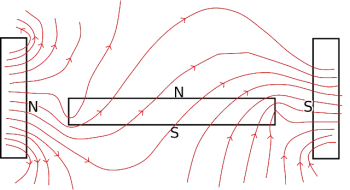
A magnetic field is a force field produced by moving electric charges. This force field is applied on other non-parallel moving charges. Together with the electric field, the magnetic field constitutes the electromagnetic field, responsible for electromagnetic interaction in space.
From the point of view of magnetism, materials can be classified into:
- Paramagnetic materials
- Diamagnetic materials
- Ferromagnetic materials
- Ferrimagnetic materials
- Antiferromagnetic materials
- This depends on the behavior of its magnetic susceptibility.
What is a magnetic field?
A magnetic field is a region of space where a magnetic force exerts its influence on moving charged particles.
It is caused by both electrical currents and the movement of charged particles, such as electrons. It is characterized by lines of magnetic flux that extend from the north to the south pole.
Magnetic fields play a fundamental role in nature, from the earth's magnetism that guides compasses to their use in technologies such as magnets, electric motors and MRIs in medicine. Understanding and manipulating magnetic fields is essential for various scientific, technological and medical applications.
Examples of magnetic fields
In the field of magnetic fields, there are various examples that illustrate their presence and functionality in different phenomena:
- Earth's magnetic field: The Earth's outer core generates a field of magnetic forces that influences particles and objects, attracting them toward the center of the planet. This phenomenon is essential for orientation and navigation on Earth.
- Magnets: Consisting of specific materials, magnets create magnetic fields around them due to the internal arrangement of electrons. Each magnet has a north pole and a south pole, being essential in numerous applications, from everyday use in holding objects to more advanced technological applications, such as hard drives and magnetic resonance imaging in medicine.
- Electric motors: Both direct current and alternating current motors use electromagnets to generate static magnetic fields. This process drives the rotary movement of the rotor, forming the basis of operation of numerous electrical devices and machinery, such as fans, washing machines and electric vehicles.
- Compass: A classic example of magnetic influence is the compass , capable of aligning its magnetic needle between the north and south poles. This instrument has been essential throughout history for navigation, allowing people to orient themselves according to the Earth's magnetic field.
- Nuclear Magnetic Resonance (MRI): In the medical field, nuclear magnetic resonance uses magnetic fields to create detailed images of the inside of the human body. This non-invasive method is crucial in medical diagnoses, providing accurate information about tissues and organs.
Tesla: Magnetic field unit
The unit of magnetic field in the International System of units is the tesla (T). One Tesla represents the field that generates a force of 1 newton (N) on an electric charge of 1 coulomb (C) moving within the field and perpendicular to the direction of the magnetic field lines at a speed of 1 m/s.
However, because the tesla is a very large unit, the gauss (G) is sometimes used: 10,000 G is equivalent to 1 T.
Characteristics of a magnetic field
The magnetic field can be approached in a similar way to the electric field, but instead of considering the electric charge (a scalar) as the source of the field, this role will be played by the magnetic dipole moment (a vector).
Magnetic forces are proportional to the generated magnetic field, that is, to the value of magnetic induction, which is a vector magnitude used to characterize a field.
The relationship between the magnetic field and an electric current is given by Ampère's law. The most general case, which includes the displacement current, is given by the Ampère-Maxwell law.
Magnetic field produced by a point charge
The magnetic field generated by a single moving charge (not by a movement of electric charges) can be approximately calculated from the equation derived from the Biot-Savart law:
where
- q is the electric charge generated by the field.
- v is the speed of movement of the load
- r is the distance from point P to the position of the load
- u r is a unit vector that goes from point P to the position of the electric charge
- μ 0 is a constant called free space permeability. Its value in the International System for vacuum is 4π 10-7 T m/A